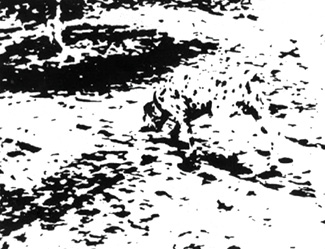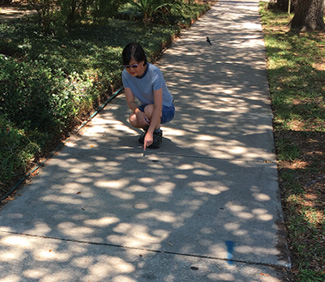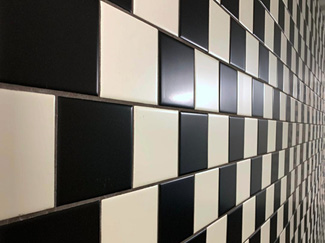focus on physics
Learning to See What’s There
The Science Teacher—July/August 2022 (Volume 89, Issue 6)
By Paul G. Hewitt
Years ago, when I taught an evening course at the Exploratorium in San Francisco, a large photo of what seemed to be random black splotches on a white background was displayed on a wall (Figure 1). A close look seemed to confirm that the spots were entirely random. Then an Exploratorium explainer would direct a visitor’s attention to the right side of the image and point out a Dalmatian dog—with its head in the middle sniffing the ground. Voilà! Once it was pointed out, most people saw the dog. If they returned to the photo in a subsequent visit, they’d see the dog right away. The trained eye sees what is there, just as the trained ear of a musician hears what others miss. Using our senses is an ongoing learning experience. We learn to perceive what is there.


Sunballs
A common experience that illustrates our failure to see what’s there is demonstrated by a favorite teaching topic of mine—the elusive sunballs in our outdoor environment, as featured in last month’s Focus on Physics. A look at the street in Figure 2 shows patches of sunlight on the surface that a casual viewer might assume have totally random shapes—but that’s an illusion. A careful look shows that the spots are circular in shape. That’s because the spots are “pinhole images” of the Sun.

After the solar nature of the circular shapes is understood, like the Dalmatian dog of Figure 1, sunballs will be recognized from then on. Again, we learn to see what’s there. We’re helped greatly if there’s somebody to point out what we don’t see clearly. Teachers are important! We can go on to question how much more there is to know with further investigation of sunballs. But unless we wish to learn more, we’re content to at least be able to identify their nature. Information overload can be a teaching no-no.
Not-so-crooked tiles
Another great Exploratorium exhibit is the tiled walls of the public restrooms (Figure 3). A closer view is shown in Figure 4. When viewed straight on, the tiles appear crooked, but when standing close to the wall and viewing the tiles at an angle, they’re clearly straight (Figure 5). A key feature of the illusion is the color of the grout between tiles. A gray grout produces the illusion, while white or black grout does not. This exhibit was inspired by a friend of the Exploratorium, psychologist Richard Gregory, who spotted this illusion on a café wall in England where it was created by accident. More about this is listed in On the Web at the end of this article.




Nobody knows
Why this illusion? To my knowledge, nobody knows. Are the crooked tiles a psychological or physical phenomenon? If a physical one, an answer is lacking. Is the lack of a physical explanation for the crooked tiles akin to the lack of an explanation for why the size of the Moon high in the sky appears smaller than when low in the sky? Although the Moon appears smaller when directly overhead, careful measurement shows it is not. There is much we know about the world about us. And there is much more we don’t know. Sifting through what we know and what we think we know can keep us on our toes.
Oppenheimer and illusions
When I first began teaching at the San Francisco Exploratorium, founder Frank Oppenheimer took me on a tour of the visual illusion exhibits. I didn’t want to tell Frank that I had already seen them, so I kept quiet and accompanied him as he did something he loved doing—teaching. He wrapped up this personal tour with a great illusion involving my hands. He asked me to raise my arms higher than my head, with one hand half as far from my eyes as the other, and make a casual judgment as to which hand looks bigger. My belief that my hands are the same size influenced my answer, which was that the closer one looked slightly larger. Then he directed me to overlap my hands a bit so I could clearly see that the closer hand was twice as tall as the far hand (Figure 6). Aha! And twice as wide, all according to perspective and the momentarily forgotten inverse-square law! So the near hand was four times the size of the far hand. Without the overlap, I’d be less apt to view them that way. The depth of this experience was emphasized when Frank asked, “What other illusions do you have that aren’t so easily checked?”


Teaching is about sharing knowledge
There I was, standing next to one of the world’s great teachers—Frank Oppenheimer—who embodied the so-evident value of teaching! A great teacher is one who tells us what to look for in nature—like a person’s first look at sunballs in a park or on a tree-lined street. That nature is there and always has been. Too much of the nature that surrounds us goes unnoticed—that is, until someone like Frank Oppenheimer comes along. Let’s all try being more like Frank, sharing what we’ve learned and pointing out what to look for. ■
Acknowledgments
I thank Ron Hipschman of the Exploratorium for the photos of Figures 1, 4, and 5. For Figure 3, I thank Gail Laird.
On the Web
Café walls illusion: http://www.richardgregory.org/papers/cafe_wall/cafe-wall_p1.htm.
For many tutorial screencasts see www.HewittDrewIt.com and www.ConceptualAcademy.com.
Paul G. Hewitt (pghewitt@aol.com) is the author of Conceptual Physics, new 13th edition; Conceptual Physical Science, 6th edition, coauthored with Leslie Hewitt and John Suchocki; and Conceptual Integrated Science, 3rd edition, with coauthors Suzanne Lyons, John Suchocki, and Jennifer Yeh.
Phenomena Physical Science Physics


